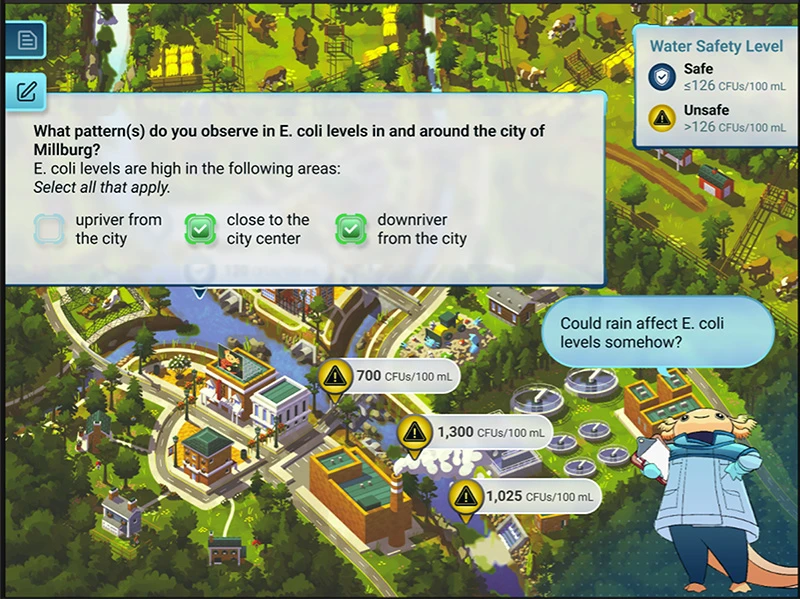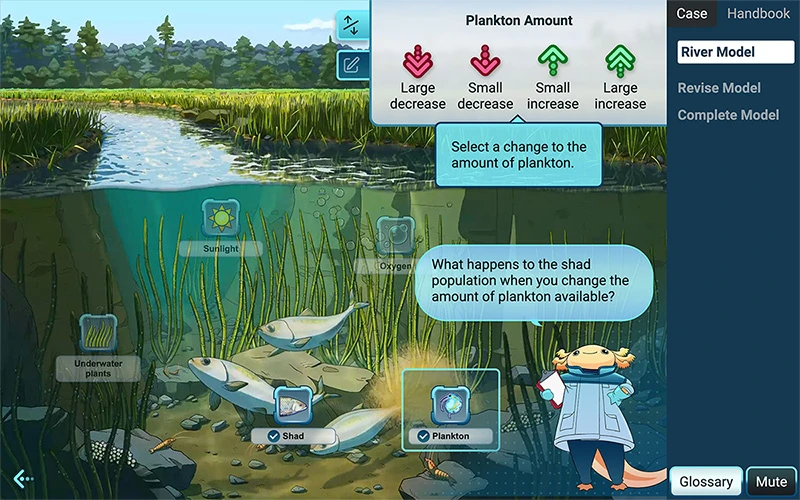Behind the Scenes of our Newest STEM Case: Microbiologist Mission

They say teamwork makes the dream work. That’s especially true for ExploreLearning STEM Cases because we team with STEM experts to create Gizmos STEM Cases. Let’s meet the professionals who brought their expertise to our newest STEM Case, Microbiologist Mission: Reducing River Runoff and Pollution.

The James River: Exploring wastewater management
Wastewater management involves collecting, treating, and potentially reusing wastewater to protect water resources and public health. It encompasses processes like screening, sedimentation, biological treatment, and disinfection. As with all STEM Cases, students are presented with a real-world issue to explore and solve. So, ExploreLearning Learning Designer Carrie Adler turned to STEM professionals associated with the James River Association in Virginia to deliver authenticity to the project.
The Microbiologist Mission STEM Case begins with the student assuming the role of a microbiologist for the Water Resources Department in the fictional city of Millburg. Residents developed bacterial infections after swimming in Dogwood River. The student must find and address the source of the bacterial contamination and ensure that river water is safe for recreation.
The impact on public river use
Effective wastewater management is crucial for protecting public river use by preventing pollution and maintaining water quality. The impacts affect human health, aquatic ecosystems, and recreational activities. There’s even an economic aspect because clean waters benefit tourism, fishing, and other industries.
Meet the STEM experts behind Microbiologist Mission
The Microbiologist Mission STEM Case enlisted the help of Matt Scott Stone, Science Education Specialist for the James River Association, and Andrea Cox, Water Reporter for the James River Association and volunteer for Lynchburg Parks and Recreation. This was the second STEM Case for Scott Stone, who previously collaborated with Adler for River Detective: The Case of the Missing Shad.

River Detective: The Case of the Missing Shad
“I studied geology in college and ended up getting a job as an environmental geologist, which means I did a lot of fieldwork,” Scott Stone said. “I went back to school and earned a master's degree in science education.” He taught earth science and oceanography in high school for 7 years. After the pandemic, he realized that he missed field experience and loved teaching. That’s when he found the opportunity with JRA to do both.
Cox came to the STEM Case from her strong desire to make a meaningful impact on her community. “I graduated from the University of North Carolina at Wilmington (UNCW) in 2020 with a degree in Environmental Science and a strong passion for watershed protection. I worked at Lynchburg’s Water Resource Recovery Facility for a year, where I gained firsthand experience in how our city treats its water. However, I was not fully satisfied with the process and wanted to explore deeper solutions,” she said. “This led me to two well-established companies, each with over 50 years of experience, specializing in water filtration and ionization, focusing on point-source and whole-house filtration.”
Driven by a love for community and the outdoors
Scott Stone and Cox share a love of the outdoors and a passion for serving the community. Scott Stone’s experiences as a child affected his outlook. His dad was in the Navy, so he went to a different school almost yearly. “One of the longest postings was in South Africa from my 6th grade to 9th grade years. I got a chance to do a lot of hiking in 9th grade with my school’s hiking club. We made it our goal to summit Mount Kilimanjaro by the end of that school year. We spent all year training, and I did summit at the very end of the school year before we moved back to the States. That really made me keep seeing opportunities to be outside.” He joined a rowing team, which put him on the water daily. He continues to find ways to connect to the river.
Cox actively seeks ways to engage in civic activities. “I value my time and the opportunity to give back to my community in various ways, such as through collaboration with the James River Association, Parks and Recreation, and the Lynchburg Daily Bread,” she said. “Becoming an Independent Distributor has provided me with the freedom to pursue a wide range of passions related to environmental recreation and non-profit efforts.”
Collaboration between ExploreLearning and STEM experts
Cox first heard about the STEM Case through her work with the James River Association River Watch Project in 2024. “I am honored to be spotlighted by such a profound organization as ExploreLearning Gizmos and look forward to seeing the final project and the impact it will have on those interested in studying watershed protection methods,” she said.
Scott Stone was familiar with Gizmos and ExploreLearning from his days of teaching STEM in the classroom. “During the pandemic, our school moved to doing virtual labs. I was already part of a curriculum team for earth science, so we developed internal structures to work with those Gizmos and teach students through additional lab experiences. It was great. There was no other option at that time. Using the Gizmos Library helped us extend what we were able to do.”
From teaching with Gizmos to supporting STEM Cases: A Full Circle Moment
The school where Scott Stone taught had a contract with ExploreLearning, and he used Gizmos extensively in his classes. In his role at the James River Association, ExploreLearning was written into a grant as a potential partner. “We knew it was a charitable company right in our watershed. We got some money from a grant to work on technology,” he said. “The ask we had from that group was to give us time to work with ExploreLearning to support our work in addition to other gadgets that could help support our centers.”
He connected with Adler and pitched the idea to her about working with shad, which resulted in his first STEM Case work for River Detective: The Case of the Missing Shad STEM Case, making a full circle moment for him from using Gizmos in the classroom to helping with development.
Highlights from working on Microbiologist Mission
Working on this River Ecosystems and Watersheds STEM Case gave Scott Stone a chance to revisit a lesson he had taught his students when he set up a virtual field trip to a wastewater disposal plant. “I think it was cool because I got to share a project I worked on with my class when I was an oceanography teacher. I took pictures, took my drone out, and did videos, just showing students where the wastewater goes after it’s treated. I was able to reuse that footage and sent it to Carrie Adler.”
Cox enjoyed the opportunity to form new connections and work alongside a team dedicated to educating the next generation of scientists. “My favorite aspect of the STEM Case is the educational component, which highlights how students can get more involved with their local watersheds by doing simple lab analysis to inform on what preventative measures are needed, if any.”
Supporting enhanced understanding with Gizmos STEM Cases
Cox believes having a resource like Gizmos STEM Cases would have impacted her as a student. “Experiencing this firsthand and performing these analyses in the watershed environment would be far more memorable than simply reading about it in a textbook,” she said.
Teaching microbiology can be difficult. “It’s hard to explain how things move in a real system when you can’t see them. It’s hard to explain to somebody how water moves in a system if you don’t have a physical model,” Scott Stone said. “When it rains too hard, wastewater overflows, backs up, and dumps out of the sewers directly into the river, not treated, unfiltered. This STEM Case is a great example of how you can use a digital model or even a video or drawing to show how water flows.”
Design and feedback were also key components for Cox and Scott Stone. “I was really impressed with the artwork. It brings the screen to life in a way that a lot of the tools don’t do,” said Scott Stone. Cox collaborated with Digital Art Manager Hilary Pierce on the STEM Case by providing footage from taking samples from the James River and demonstrating the testing process in the lab. “I conducted tests on temperature, turbidity, conductivity, and E. coli,” she said.
“The fact that there’s so much feedback. That’s what I liked about the STEM Case,” said Scott Stone. “When a student makes a change, they can see the result of that change. I think it helps students understand the system better.”
A new Gizmos STEM Case about microbiology and wastewater
Put your students in grades 6-8 on the virtual river and watch them take on the work of microbiologists, addressing the source of the bacterial contamination and ensuring that Dogwood River water is safe for recreation. Through this authentic scenario, students become active learners, forming ideas, testing solutions, and solving real-world problems.

Are you interested in experiencing the impact of Gizmos and STEM Cases on student achievement with your class? Take a free trial today!
Start My Trial

We value educators' insights on what really works in the classroom. Would you like to be a Tech Tester for this or other STEM Cases to provide student user testing feedback? Join the Collab Crew.
Count Me In